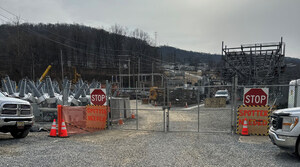Jersey Central Power & Light Submits Rate Filing For Hurricane Sandy Restoration Costs
Company Would Continue to Have Lowest Rates Among New Jersey's Regulated Electric Utilities
MORRISTOWN, N.J., Feb. 22, 2013 /PRNewswire/ -- Jersey Central Power & Light (JCP&L) today filed a rate request to recover costs associated with rebuilding the electrical infrastructure in northern and central New Jersey following Hurricane Sandy and heavy snows from a nor'easter in 2012. The storms affected virtually every one of JCP&L's 1.1 million customers, and the resulting damage led to the largest restoration effort in the company's history.
The filing is a continuation of the process that began last year when the New Jersey Division of Rate Counsel filed a petition challenging the level of JCP&L's electric rates. Ultimately, JCP&L filed a rate increase request with the New Jersey Board of Public Utilities (BPU) on November 30, 2012, detailing its spending on operations, maintenance, capital investment and the costs associated with restoring power to customers after Hurricane Irene and the October snowstorm in 2011. At the time, JCP&L said the rate filing would be amended at a later date to include restoration costs from Hurricane Sandy.
Even with the proposed increase, JCP&L would continue to have the lowest residential electric rates among the four New Jersey electric distribution companies regulated by the BPU based on a state-wide average of 650 kilowatts hours of monthly usage.
Under New Jersey law, the ratemaking process allows electric utility companies to recover the costs associated with providing electric service to customers, including major storm costs. Of the approximately $630 million it spent on Hurricane Sandy, JCP&L's request seeks to recover in this proceeding approximately $345 million for capital expenditures incurred while restoring service to customers and approximately $258 million in non-capital costs which have been deferred. The company is proposing to recover these deferred costs through its base rates over a six-year period, beginning at the conclusion of the rate case now underway.
Hurricane Sandy restoration costs include the cost of cutting and clearing approximately 65,000 trees, repairing substations, and replacing 6,700 utility poles, 19,200 crossarms, 3,600 transformers and 400 miles of wire. Other significant costs during the Hurricane Sandy restoration effort were the operational, labor and logistics expenditures associated with deploying approximately 13,000 workers – some from as far away as Florida and Oregon – to assess and repair the damage from this unprecedented event.
If approved by the BPU, JCP&L's rate filing, which would include the Hurricane Sandy restoration costs and the previously submitted rate request, would result in about a 4.5 percent overall rate increase for an average JCP&L residential customer using 650 kilowatt hours of electricity. This amount will be offset by a recently announced 3 percent decrease in generation service costs as a result of the BPU's electricity auction.
While the effect on individual customers' bills would depend on their specific residential or general service rate and actual monthly use, the impact from Hurricane Sandy and the previously proposed rate request would result in an increase in the average monthly bill from $98.10 to $102.54, or $4.44 for a JCP&L residential customer using 650 kilowatt hours of electricity.
In an effort to offset Hurricane Sandy repair costs, JCP&L has identified $2.6 billion in projects for funding from the New Jersey Community Development Block Grant (CDBG) program. As proposed, a majority of the CDBG funds would be targeted for a comprehensive storm hardening program that can have a positive impact on future reliability and deployment of smart grid technologies while promoting economic development and job creation in communities throughout JCP&L's service area. The remainder of the grant funding could be used to offset the costs related to JCP&L's Hurricane Sandy service restoration effort. If approved for this purpose, the CDBG grants would be used to help reduce JCP&L customers' electric bills.
JCP&L is a subsidiary of FirstEnergy Corp. (NYSE: FE). JCP&L serves 1.1 million customers in the counties of Burlington, Essex, Hunterdon, Mercer, Middlesex, Monmouth, Morris, Ocean, Passaic, Somerset, Sussex, Union and Warren. Follow JCP&L on Twitter @JCP_L and Facebook at www.facebook.com/JCPandL.
FirstEnergy is a diversified energy company dedicated to safety, reliability and operational excellence. Its 10 electric distribution companies form one of the nation's largest investor-owned electric systems, serving customers in Maryland, Ohio, Pennsylvania, New Jersey, New York and West Virginia. Its generation subsidiaries control more than 20,000 megawatts of capacity from a diversified mix of scrubbed coal, non-emitting nuclear, natural gas, hydro, pumped-storage hydro and other renewables. Follow FirstEnergy on Twitter @FirstEnergyCorp.
Forward-Looking Statements: This news release includes forward-looking statements based on information currently available to management. Such statements are subject to certain risks and uncertainties. These statements include declarations regarding management's intents, beliefs and current expectations. These statements typically contain, but are not limited to, the terms "anticipate," "potential," "expect," "believe," "estimate" and similar words. Forward-looking statements involve estimates, assumptions, known and unknown risks, uncertainties and other factors that may cause actual results, performance or achievements to be materially different from any future results, performance or achievements expressed or implied by such forward-looking statements. Actual results may differ materially due to: the speed and nature of increased competition in the electric utility industry, the impact of the regulatory process on the pending matters before FERC and in the various states in which we do business including, but not limited to, matters related to rates, the uncertainties of various cost recovery and cost allocation issues resulting from ATSI's realignment into PJM, economic or weather conditions affecting future sales and margins, regulatory outcomes associated with Hurricane Sandy, changing energy, capacity and commodity market prices and availability, financial derivative reforms that could increase our liquidity needs and collateral costs, the continued ability of our regulated utilities to collect transition and other costs, operation and maintenance costs being higher than anticipated, other legislative and regulatory changes, and revised environmental requirements, including possible GHG emission, water intake and coal combustion residual regulations, the potential impacts of CAIR, and any laws, rules or regulations that ultimately replace CAIR, and the effects of the EPA's MATS rules, the uncertainty of the timing and amounts of the capital expenditures that may arise in connection with any litigation, including NSR litigation or potential regulatory initiatives or rulemakings (including that such expenditures could result in our decision to deactivate or idle certain generating units), the uncertainties associated with our plans to deactivate our older unscrubbed regulated and competitive fossil units and our plans to change the operations of certain fossil plants, including the impact on vendor commitments, and the timing of those deactivations and operational changes as they relate to, among other things, the RMR arrangements and the reliability of the transmission grid, issues that could result from the NRC's review of the indications of cracking in the Davis Besse Plant shield building, adverse regulatory or legal decisions and outcomes with respect to our nuclear operations (including, but not limited to the revocation or non-renewal of necessary licenses, approvals or operating permits by the NRC or as a result of the incident at Japan's Fukushima Daiichi Nuclear Plant), adverse legal decisions and outcomes related to ME's and PN's ability to recover certain transmission costs through their transmission service charge riders, the continuing availability of generating units, changes in their operational status and any related impacts on vendor commitments, replacement power costs being higher than anticipated or inadequately hedged, the ability to comply with applicable state and federal reliability standards and energy efficiency mandates, changes in customers' demand for power, including but not limited to, changes resulting from the implementation of state and federal energy efficiency mandates, the ability to accomplish or realize anticipated benefits from strategic goals, our ability to improve electric commodity margins and the impact of, among other factors, the increased cost of fuel and fuel transportation on such margins, the ability to experience growth in the Regulated Distribution and Competitive Energy Services segments, changing market conditions that could affect the measurement of liabilities and the value of assets held in our NDTs, pension trusts and other trust funds, and cause us and our subsidiaries to make additional contributions sooner, or in amounts that are larger than currently anticipated, the impact of changes to material accounting policies, the ability to access the public securities and other capital and credit markets in accordance with our financing plans, the cost of such capital and overall condition of the capital and credit markets affecting us and our subsidiaries, changes in general economic conditions affecting us and our subsidiaries, interest rates and any actions taken by credit rating agencies that could negatively affect us and our subsidiaries' access to financing, increased costs thereof, and increase requirements to post additional collateral to support outstanding commodity positions, LOCs and other financial guarantees, the state of the national and regional economy and its impact on our major industrial and commercial customers, issues concerning the soundness of domestic and foreign financial institutions and counterparties with which we do business, the risks and other factors discussed from time to time in our SEC filings, and other similar factors. The foregoing review of factors should not be construed as exhaustive. New factors emerge from time to time, and it is not possible for management to predict all such factors, nor assess the impact of any such factor on FirstEnergy's business or the extent to which any factor, or combination of factors, may cause results to differ materially from those contained in any forward-looking statements. FirstEnergy expressly disclaims any current intention to update, except as required by law, any forward-looking statements contained herein as a result of new information, future events or otherwise.
SOURCE FirstEnergy Corp.
WANT YOUR COMPANY'S NEWS FEATURED ON PRNEWSWIRE.COM?
Newsrooms &
Influencers
Digital Media
Outlets
Journalists
Opted In





Share this article